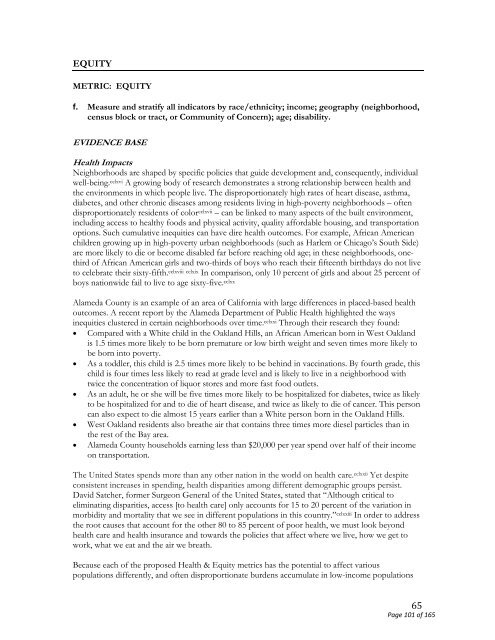Draft MTP/SCS Comments Received - sacog
Draft MTP/SCS Comments Received - sacog
Draft MTP/SCS Comments Received - sacog
You also want an ePaper? Increase the reach of your titles
YUMPU automatically turns print PDFs into web optimized ePapers that Google loves.
EQUITY<br />
METRIC: EQUITY<br />
f. Measure and stratify all indicators by race/ethnicity; income; geography (neighborhood,<br />
census block or tract, or Community of Concern); age; disability.<br />
EVIDENCE BASE<br />
Health Impacts<br />
Neighborhoods are shaped by specific policies that guide development and, consequently, individual<br />
well-being. cclxvi A growing body of research demonstrates a strong relationship between health and<br />
the environments in which people live. The disproportionately high rates of heart disease, asthma,<br />
diabetes, and other chronic diseases among residents living in high-poverty neighborhoods – often<br />
disproportionately residents of color cclxvii – can be linked to many aspects of the built environment,<br />
including access to healthy foods and physical activity, quality affordable housing, and transportation<br />
options. Such cumulative inequities can have dire health outcomes. For example, African American<br />
children growing up in high-poverty urban neighborhoods (such as Harlem or Chicago’s South Side)<br />
are more likely to die or become disabled far before reaching old age; in these neighborhoods, onethird<br />
of African American girls and two-thirds of boys who reach their fifteenth birthdays do not live<br />
to celebrate their sixty-fifth. cclxviii cclxix In comparison, only 10 percent of girls and about 25 percent of<br />
boys nationwide fail to live to age sixty-five. cclxx<br />
Alameda County is an example of an area of California with large differences in placed-based health<br />
outcomes. A recent report by the Alameda Department of Public Health highlighted the ways<br />
inequities clustered in certain neighborhoods over time. cclxxi Through their research they found:<br />
Compared with a White child in the Oakland Hills, an African American born in West Oakland<br />
is 1.5 times more likely to be born premature or low birth weight and seven times more likely to<br />
be born into poverty.<br />
As a toddler, this child is 2.5 times more likely to be behind in vaccinations. By fourth grade, this<br />
child is four times less likely to read at grade level and is likely to live in a neighborhood with<br />
twice the concentration of liquor stores and more fast food outlets.<br />
As an adult, he or she will be five times more likely to be hospitalized for diabetes, twice as likely<br />
to be hospitalized for and to die of heart disease, and twice as likely to die of cancer. This person<br />
can also expect to die almost 15 years earlier than a White person born in the Oakland Hills.<br />
West Oakland residents also breathe air that contains three times more diesel particles than in<br />
the rest of the Bay area.<br />
Alameda County households earning less than $20,000 per year spend over half of their income<br />
on transportation.<br />
The United States spends more than any other nation in the world on health care. cclxxii Yet despite<br />
consistent increases in spending, health disparities among different demographic groups persist.<br />
David Satcher, former Surgeon General of the United States, stated that “Although critical to<br />
eliminating disparities, access [to health care] only accounts for 15 to 20 percent of the variation in<br />
morbidity and mortality that we see in different populations in this country.” cclxxiii In order to address<br />
the root causes that account for the other 80 to 85 percent of poor health, we must look beyond<br />
health care and health insurance and towards the policies that affect where we live, how we get to<br />
work, what we eat and the air we breath.<br />
Because each of the proposed Health & Equity metrics has the potential to affect various<br />
populations differently, and often disproportionate burdens accumulate in low-income populations<br />
65<br />
Page 101 of 165
















